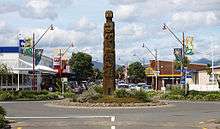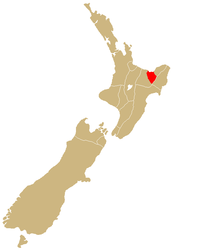Whakatōhea
| Whakatōhea | |
|---|---|
| Iwi of New Zealand | |
 Ōpōtiki township | |
 | |
| Rohe (region) | Bay of Plenty |
| Waka (canoe) | Arautauta, Mataatua nukutere |
| Population | 9,948 |
Whakatōhea is a Māori iwi located in the eastern Bay of Plenty region of New Zealand.[1] The iwi comprises six hapu: Ngāi Tamahaua, Ngāti Ira, Ngāti Ngahere, Ngāti Patumoana, Ngāti Ruatākena and Ūpokorehe.[2] In the 2006 Census, 12,072 people claimed an affiliation with Whakatōhea.[3]
The iwi is traditionally centred in the area around the town of Opotiki. The traditional territorial lands extend eastwards from Ohiwa Harbour to Opape along the coastline, and inland to Matawai. These lands have long held an abundance of food resources, particularly seafood. Most of the marae of the iwi are located near the coast, historically to defend its marine resources.[4]
History
Early history
Whakatōhea can trace their history to the arrival of Māori settlers on the Nukutere and Mataatua canoes. Whakatōhea are the descendants of Muriwai, the eldest daughter of Wekanui and Irākewa. Wekanui and Irākewa had three children; Muriwai being the eldest followed by Toroa and Puhi. They also had a half brother, Tāneatua. It is, according to Whakatōhea legend that Muriwai spoke the famous words "kia tū whakatāne au i ahau" translated to "make me stand like a man". When Mātaatua was being swept back out to sea with no man to pull the waka back in. It was these famous words the gave her the right to pull the waka back to safety. It was from these words that Whakatane also gets its name.
Tūtāmure was a descendant of the Nukutere settlers, and was the leader of the Panenehu tribe. Hine-i-kauia was a descendant of the Mataatua settlers, who arrived in New Zealand nine generations after the Nukutere settlers. Tūtāmure and Hine-i-kauia were married, and their descendants would eventually form the Ngāti Ruatākena hapu. The ancestoral house at Omarumutu marae is named Tutamure and the dining room is named Hine-i-kauia.
For centuries, Whakatōhea fought many battles with their neighbours, including Ngāi Tai in the east, Ngāti Awa and Ngāi Tūhoe in the west.[4]
Modern history
The iwi initially had good relations with European settlers and Christian missionaries. However, in 1865, following the murder of German missionary Carl Völkner, and with increasing demands from European settlers for more land, Crown soldiers invaded Te Whakatōhea land. Almost 600 km² of Whakatōhea land was confiscated by the Crown under the New Zealand Settlements Act of 1863.
During the twentieth century there was increasing recognition that Whakatōhea had suffered grievances at the hands of the Crown. In 1996, the New Zealand government signed a Deed of Settlement, acknowledging and apologising for the invasion and confiscation of Whakatōhea lands, and the subsequent economic, cultural and developmental devastation suffered by the iwi. Whakatōhea are presently preparing to negotiate a full settlement with the New Zealand government.[4]
Hapū and marae
Te Ūpokorehe
Te Ūpokorehe is one of the hapū (sub-tribes) of Whakatōhea.
It has three marae (communual grounds) and wharenui (meeting house):
- Kutarere marae and Te Poho o Tamaterangi wharenui at Kutarere
- Maromahue marae and Te Poho o Kahungunu wharenu at Waiotahe
- Roimata marae and Te Ao Marama wharenui at Kutarere[2]
Other hapū
In addition to Te Ūpokorehe, there are also five other hapū (sub-tribes) in Whakatōhea.
Each has their own marae (communual grounds) and wharenui (meeting houses).
- Ngāi Tamahaua (Ngāi Tama), based at Opape marae and Muriwai wharenui at Opape
- Ngāti Irapuaia (Ngāti Ira), based at Ōpeke / Opekerau / Waioeka marae and Irapuaia wharenui at Waioweka
- Ngāti Ngahere, based at Te Rere marae and Te Iringa wharenui at Ōpōtiki
- Ngāti Patumoana, based at Waiaua marae and Ruamoko wharenui at Waiaua
- Ngāti Ruatākena (Ngāti Rua), based at Ōmarumutu marae and Tūtāmure wharenui at Ōmarumutu[2]
Governance
Whakatōhea Māori Trust Board
The Whakatōhea Māori Trust Board was established in 1952 to administer the assets of the iwi, and provides members with education, health services and training in various commercial fields..[1] It is a charitable trust governed by two representatives from each of the six hapū, and based in Ōpōtiki.[2]
The trust represents the tribe's fisheries interest under the Māori Fisheries Act 2004, and its aquaculture interests under the Māori Commercial Aquaculture Claims Settlement Act 2004. It represents the tribe during consultation on resource consent applications under the Resource Management Act 1991, through a legally recognised Te Upokorehe Iwi Resource Management Team.[2]
Whakatōhea Pre-Settlement Claims Trust
The Whakatōhea Pre-Settlement Claims Trust represents the tribe during Treaty of Waitangi settlement negotiations. The New Zealand Government recognised the trust's mandate to represent the iwi with an Agreement in Principle signed with the Crown on 18 August 2017. The trust is governed by one trustee elected from each of six hapū, one trustee appointed from each of eight marae, and an additional trustee appointed by Whakatōhea Māori Trust Board.
The trust is administered by the same staff as the trust board, in the same offices in Ōpōtiki.[2]
Local government
The tribal area of Whakatōhea is located within the territory of Ōpōtiki District Council.
It is within the boundaries of Bay of Plenty Regional Council.[2]
Media
Sun FM
Pan-tribal iwi station Sea 92FM broadcasts to members of Whakatōhea, Ngāti Tai and Te Whānau-ā-Apanui in the Opotiki area.[5] It is operated by pan-tribal service provider Whakaatu Whanaunga Trust, and is available on 92.0 FM. It operates the low-power Opotiki 88.1 FM, geared towards a young demographic.[6]
Notable people
- Tuakana Aporotanga, tribal leader and ringatu tohunga
- Henare Te Raumoa Huatahi Balneavis, interpreter and administrator
- Whirimako Black, singer and actress
- Pāora Kīngi Delamere, carpenter and boat-builder
- Matiu Dickson, academic and politician
- George Gage, Ringatū minister
- Wira Gardiner, soldier, civil servant and writer
- Akenehi Hei, nurse and midwife
- Kayla Imrie, canoeist
- Paratene Matchitt, sculpture and painter
- Gareeb Stephen Shalfoon, musician
- Charles Shelford, soldier
- Frank Shelford, rugby union player
- Matiu Te Auripo Te Hau, teacher and community leader
- Hira Te Popo, tribal leader
- Michael Walker, academic
See also
References
- 1 2 "Te Whakatōhea Māori Trust Board website". Retrieved 2 April 2007.
- 1 2 3 4 5 6 7 "TKM Whakatōhea". tkm.govt.nz. Te Puni Kōkiri, New Zealand Government. Retrieved 21 March 2018.
- ↑ "2006 Census – QuickStats About Māori (revised)". Statistics New Zealand. 4 April 2007. Archived from the original on 28 September 2007. Retrieved 25 May 2007.
- 1 2 3 Walker, Ranginui (26 September 2006). "Te Whakatōhea". Te Ara – the Encyclopedia of New Zealand. Retrieved 2 April 2007.
- ↑ Carlsson, Sven. "Contractors install the Whakaatu Whanaunga Trust's far-reaching antenna last Friday". Opitiki News. Opitiki News. Retrieved 26 April 2015.
- ↑ "Iwi Radio Coverage" (PDF). maorimedia.co.nz. Māori Media Network. 2007. Retrieved 14 June 2015.